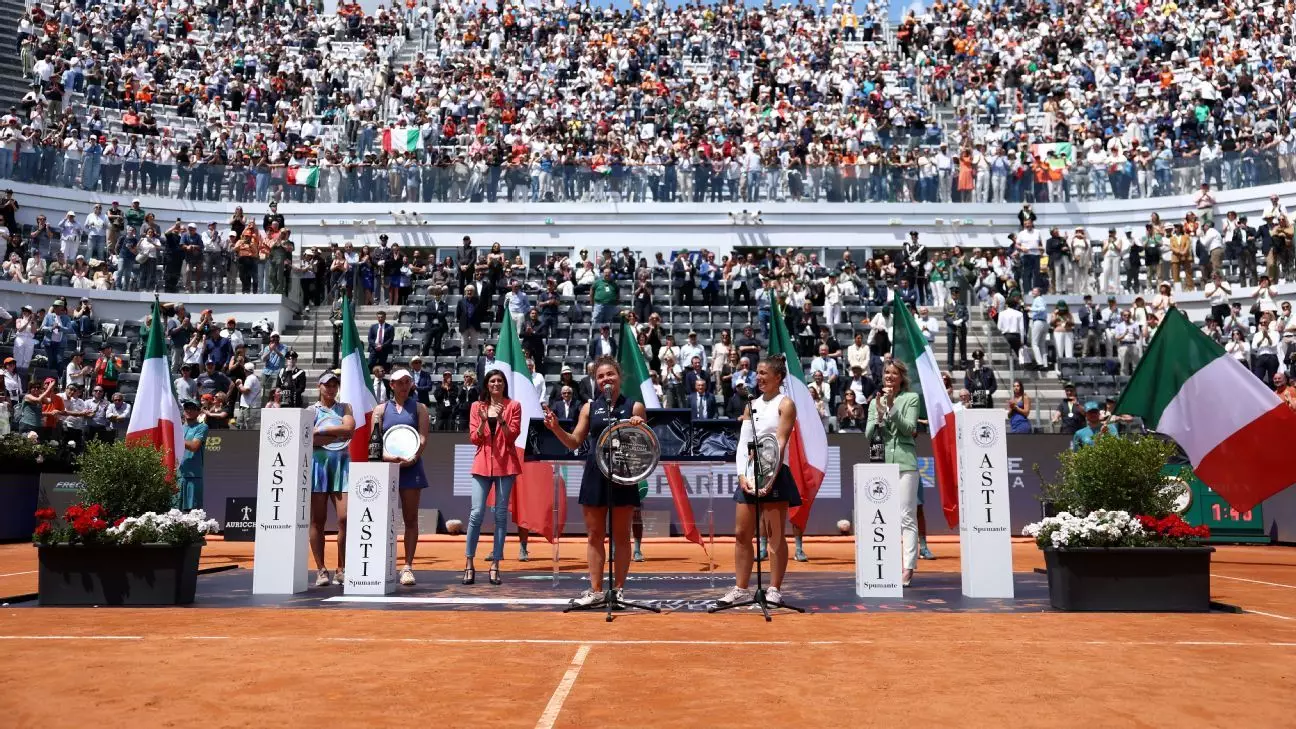In recent times, Italian tennis has not just emerged but exploded onto the global stage, with players like Jannik Sinner leading the charge. He is not merely a reflection of Italy’s potential in the sport; he embodies a dynamic shift that reshapes the landscape of men’s tennis. The remarkable success extends beyond Sinner, with significant contributions from Jasmine Paolini, who recently became the first Italian woman to clinch the Italian Open title in four decades. As Paolini prepares to ascend to the No. 4 position in the women’s rankings, her accomplishments mark not inconsequential footnotes in history, but rather pivotal moments in the colorful tapestry of Italian sports.
Italy’s prominence in tennis is further bolstered by emerging talents like Lorenzo Musetti, Federico Cinà, and Tyra Caterina Grant. Their consistent performances hint at a bright future, suggesting that the Italian campus of tennis is ripe for domination. Yet, despite basking in the glow of recent victories, leaders within the sport, notably Angelo Binaghi, President of the Italian Tennis and Padel Federation, are not content to rest on their laurels.
Aspirations for Greatness
Binaghi possesses ambitious dreams, notably aiming to elevate the Italian Open to the status of the fifth Grand Slam. This bold vision of reshaping a century-old tennis hierarchy is nothing short of revolutionary. His assertion, “In what other part of society is there a monopoly that lasts for more than 100 years?” provokes thought, forcing audiences to challenge long-standing norms in the sport. Binaghi’s impassioned plea for change is a clarion call against stagnation, urging stakeholders to consider that merely having four major tournaments is not only an issue of fairness but also stifles the sport’s potential to evolve.
The Italian Open, currently classified as a Masters Series event, is not far from the glimmering heights of the Grand Slam tournaments. It runs for two weeks, similar in duration to the major championships, and has witnessed exponential growth recently, boosted by home-grown talents. The recent ATP Finals in Turin and the impending Davis Cup Final further solidify Italy’s stance as a burgeoning powerhouse in the tennis realm. Yet, Binaghi’s vision to craft a fifth Slam remains audacious and ambitious, possibly indicative of a yearning to write a new chapter in tennis history.
Infrastructure and Ambitions
Plans to enhance infrastructure for the Italian Open reflect the determination to consolidate Italy’s aspirations within the sport. The proposed retractable roof over the main stadium at Campo Centrale, projected to cost around 60 million euros, exemplifies a significant financial commitment to elevate the tournament experience. This infrastructure overhaul, slated for completion by 2028, not only enhances the audience experience—by increasing seating capacity—but serves as an indication of how seriously Italy takes its ambitions in the tennis world.
The expansion of the event grounds at Foro Italico from 12 to 20 hectares further signifies a bloom in tennis enthusiasm. The addition of various venues, such as the Stadio dei Marmi, showcases a desire to create a multi-court environment capable of hosting a plethora of matches simultaneously—a move designed to enrich the tournament atmosphere and boost attendance. The mathematics of extending reach in an arena as competitive as tennis is evident: more venues equal more opportunities, whether for players, fans, or sponsors.
Market Savvy and Opportunities
At the heart of Binaghi’s vision is a keen awareness of the international market’s dynamism. His interest in acquiring the license for the Madrid Open illustrates a strategic mindset intended to consolidate Italy’s position in the tennis calendar. By merging the essence of the Madrid tournament into the framework of the Italian Open, Binaghi aims to create a singular event that could rival the status of the esteemed Grand Slams.
Seizing every opportunity, whether small local tournaments or prestigious ATP events, demonstrates a robust strategy for Italy’s tennis growth. Binaghi’s assertion about maximizing existing events speaks to an understanding of the larger picture—one that acknowledges the interconnectedness of success in tennis and a well-rounded approach to tournament management.
Italy’s grand ambitions in tennis, driven by a mix of historical change and emerging player talent, are indicative of a nation intent on cementing its legacy on the court. As Italian tennis looks to the future, one can’t help but feel the thrill of inevitability surrounding this fascinating evolution.

